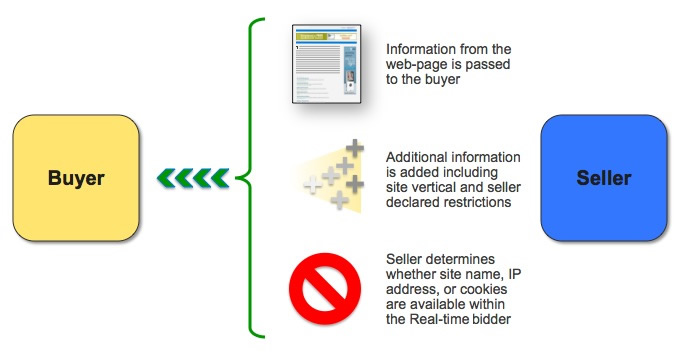Questa guida fornisce una panoramica dei concetti relativi alle offerte in tempo reale (RTB) necessari per scrivere applicazioni di offerenti che possono partecipare alle offerte in tempo reale di Authorized Buyers.
Nozioni di base
Un'applicazione offerente può comunicare con Google utilizzando uno dei protocolli RTB supportati. Una richiesta di offerta inviata a un'applicazione fornisce il contesto di almeno un'opportunità di annuncio in modo che l'offerente possa determinare la creatività e l'importo dell'offerta ottimali (se presenti) per ogni impressione. Uno strumento di offerta può rispondere con una risposta all'offerta per fare almeno un'offerta e specificare la creatività da inserire per le opportunità pubblicitarie inviate nella richiesta.

Il seguente scenario è una possibile interazione tra un'applicazione bidder e Authorized Buyers:
- Google invia all'applicazione offerente una richiesta di offerta che descrive un'impressione
venduta all'asta. L'account dell'offerente è configurato per utilizzare
OpenRTB nel formato Protobuf, quindi la richiesta arriva come
BidRequestserializzato come mostrato in openrtb.proto. Per scoprire come la tua applicazione deve interpretare la richiesta di offerta, consulta Elaborazione della richiesta. -
L'applicazione dell'offerente analizza la richiesta e applica la logica di offerta per costruire un
BidResponseche includa un'offerta e una creatività per l'opportunità pubblicitaria. L'applicazione serializza quindi la risposta all'offerta e la invia a Google. Per scoprire come l'applicazione deve creare e restituire una risposta all'offerta, consulta la sezione Creazione della risposta. -
La risposta all'offerta viene ricevuta e la sua offerta partecipa all'asta aperta, dove vince l'impressione perché è l'offerta più alta. Di conseguenza, viene posizionata la creatività specificata nella risposta.
Seleziona un protocollo
Il protocollo delle offerte in tempo reale specifica gli indicatori che la tua applicazione può utilizzare per valutare e fare offerte per ogni impressione inviata in una richiesta, nonché come costruire una risposta. Esistono due modi per modificare il protocollo associato alla tua applicazione bidder:
- Contatta il tuo Technical Account Manager per modificarlo manualmente.
- Utilizza l'API REST di Authorized Buyers per modificarlo in modo programmatico.
Protocolli supportati
Authorized Buyers supporta due protocolli RTB:
- OpenRTB (Protobuf)
Un'implementazione della specifica OpenRTB che utilizza Protobuf.
- OpenRTB (JSON)
Un'implementazione della specifica OpenRTB che utilizza JSON.
Informazioni sui buffer di protocollo
Protobuf è un formato open source per rappresentare e serializzare informazioni strutturate.
Se vuoi utilizzare OpenRTB Protobuf, devi installare il compilatore del protocollo
e il runtime Protobuf per la lingua che hai scelto. Puoi quindi scaricare i file proto che intendi utilizzare ed eseguire il compilatore per generare una libreria in grado di serializzare o deserializzare i messaggi definiti nel proto, ad esempio BidRequest o BidResponse. Questo
riferimento Protobuf
mostra come farlo per diverse lingue.
Aggiornamenti dei protocolli
I protocolli RTB verranno modificati man mano che Google aggiunge nuove funzionalità e ne ritira altre. Le modifiche verranno annunciate molto prima che diventino effettive, il che dovrebbe darti tempo sufficiente per rimuovere eventuali dipendenze che la tua applicazione potrebbe avere da campi la cui deprecazione è pianificata. Per saperne di più sulla gestione dei campi ritirati, consulta Adattamento al ritiro dei campi BidRequest.
Passaggi successivi
I seguenti contenuti forniscono maggiori dettagli sui concetti delle offerte in tempo reale:
- Elabora la richiesta: Come analizzare e interpretare gli indicatori presenti nella maggior parte delle richieste di offerta.
- Crea la risposta: Come creare una risposta all'offerta e campi specificati comunemente nella risposta.
- Guida OpenRTB: riferimento per l'implementazione di Authorized Buyers della specifica OpenRTB, oltre alle estensioni specifiche di Authorized Buyers. Vengono descritti casi limite e limitazioni specifici di questa implementazione e vengono identificati i campi equivalenti nel protocollo Google.
- Requisiti per la pubblicazione di annunci di terze parti: Definisce le norme che i partecipanti all'asta devono rispettare per utilizzare vari formati degli annunci, nonché le specifiche tecniche di questi formati.
- Pretargeting: Come configurare l'applicazione di offerente per ricevere solo impressioni che soddisfano i tuoi criteri di targeting.
- Corrispondenza dei cookie: Riferimento al servizio di corrispondenza dei cookie e ad altri servizi correlati utilizzati per il remarketing.
- Limitazioni di latenza e peering: Dettagli sulle sedi di trading e su come ridurre la latenza, ad esempio tramite il peering.
- Test e rilascio dell'applicazione: Dettagli su come iniziare a testare l'applicazione bidder con il traffico inviato da Google su larga scala.

